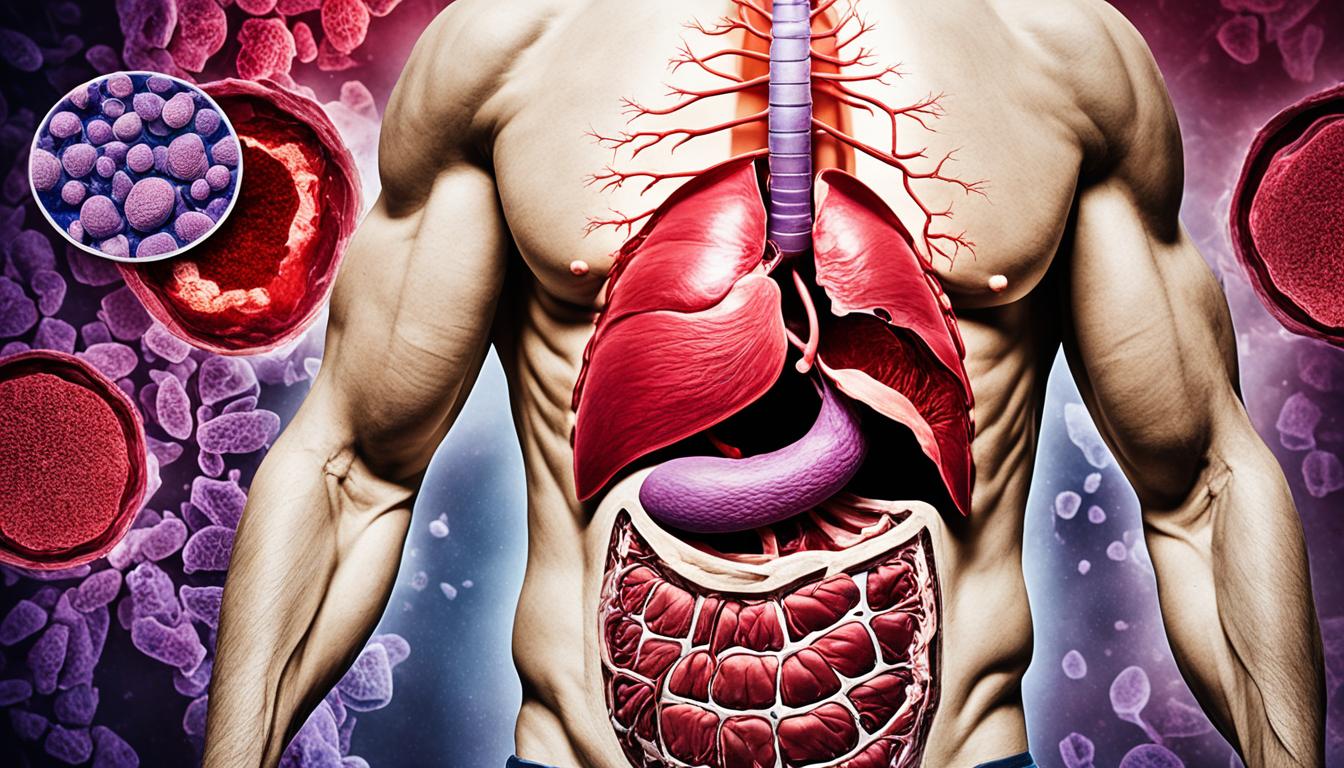Liver cancer, or hepatic cancer, is a big health problem worldwide. It’s especially tough on those with end-stage liver disease (ESLD). Stem cell treatment shows hope for these patients. Different kinds of stem cells, like mesenchymal stem cells (MSCs) and induced pluripotent stem cells (iPSCs), are being used. Clinical trials have been positive, but we need more research on their long-term effects and risks.
Key Takeaways:
- Liver cancer, also known as hepatic cancer, is a significant global health concern.
- Stem cell-based therapy holds promise for treating end-stage liver disease.
- Clinical trials have shown positive results, but further research is necessary.
- Various types of stem cells are being explored for their potential in liver disease treatment.
- Understanding the long-term outcomes and potential side effects of stem cell therapy is crucial for liver cancer treatment.
Risk Factors and Types of Liver Cancer
Liver cancer is a complex disease, with many risk factors and types. It’s key to know these to find it early and treat it effectively. Let’s look at the reasons and types of liver cancer.
Risk Factors
Risk factors for liver cancer include:
- Chronic hepatitis B or C virus infections
- Fatty liver disease
- Alcohol abuse
- Obesity
- Metabolic abnormalities
These factors can make liver cancer more likely. So, managing and preventing them is important.
Types of Liver Cancer
The most common liver cancer is hepatocellular carcinoma (HCC). HCC comes from hepatocytes, the liver’s nutrient-processing cells. It makes up 75-85% of liver cancers.
There are other types, like:
| Type | Description |
|---|---|
| Bile Duct Cancer (Intrahepatic Cholangiocarcinoma) | Arises from the cells lining the bile ducts within the liver |
| Hemangiosarcoma | A rare form that develops from blood vessel cells |
| Angiosarcoma | Another rare type that originates from the inner lining of blood vessels |
| Fibrolamellar-Hepatocellular Carcinoma (FLL-HCC) | A rare variant of HCC that typically affects young adults without underlying liver disease |
| Hepatoblastoma | A rare liver cancer occurring primarily in children |
| Metastatic Liver Cancer | Cancer that has spread to the liver from other parts of the body |
There are also benign liver tumors, like cysts, adenomas, and hemangiomas. Though not cancerous, they still need attention based on their size and effect on liver function.
Learning about liver cancer’s risks and types helps find it early. This knowledge can lead to better treatment results.
Stages and Symptoms of Liver Cancer
Liver cancer, just like other forms, gets staged by the tumor’s growth and spread. This helps doctors see how serious the cancer is. It also guides what treatments to use.
Liver cancer can move from stage I to IV. The higher the stage, the more the disease has spread.
Stage I:
In stage I, the tumor is small and stays in the liver. It doesn’t affect blood vessels or lymph nodes nearby.
Stage II:
Stage II means the tumor is bigger than before, but it’s still just in the liver. It might touch blood vessels but not lymph nodes yet.
Stage III:
By stage III, the tumor has grown more. It might have reached blood vessels or lymph nodes.
But it hasn’t gone to other parts of the body.
Stage IV:
Stage IV is the most serious. The tumor goes past the liver. It reaches the lungs or bones.
The signs of liver cancer change with the disease’s stage. Some common symptoms include:
- Loss of appetite
- Pain in the upper stomach or shoulder
- Weakness or fatigue
- Weight loss for no clear reason
- Jaundice (skin and eyes turn yellow)
- Nausea and vomiting
- Fever
- Swollen or painful belly
- High liver enzymes in tests
If you notice these symptoms, see a doctor. Getting diagnosed early is very important for treating liver cancer.
Diagnosis involves tests like imaging, blood tests, and biopsies. These tests can spot liver issues and types of cancer. They help figure out the best treatment.
Knowing the stages and symptoms of liver cancer is vital for quick treatment. If you’re at risk or have symptoms, don’t wait. See a doctor for advice and care.
Conclusion
Liver cancer is a big health issue with few treatment choices and a bleak outlook for many. Treatments now include surgery, chemotherapy, and more. Still, new and better ways to help patients with severe liver disease are needed.
Stem cell therapy is showing great promise as a way to fight liver cancer and end-stage liver disease. It uses stem cells’ ability to heal and stop tumors. Trials show hope, but we need more studies to know the long-term effects and any risks.
Many are working on making stem cell therapy even better for liver cancer. They aim to find the best way to get stem cells to the liver. Plus, they want to make sure the cells last, work well, and help patients more. These efforts could change how we treat liver cancer and give better outcomes to patients.

